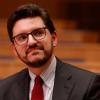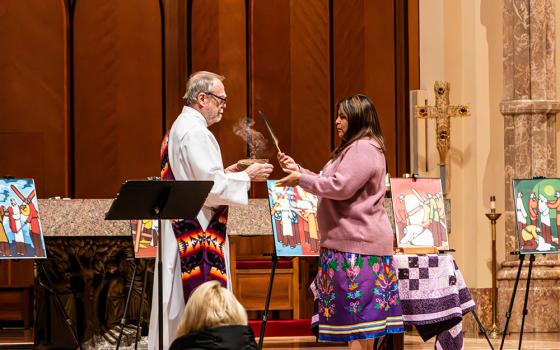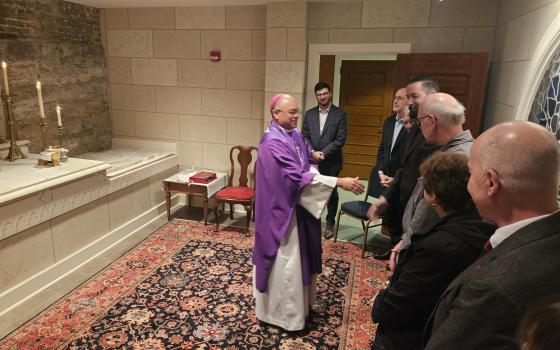
Benedictine Sr. Joan Chittister (NCR photo/Tom Fox)
Just about any way you look at it, it's five days that could shape the course of some six decades of history.
Nearly four months after a harsh Vatican critique, the leaders of the organization that represents 80 percent of U.S. women religious are due to gather Aug. 7-10 in St. Louis for their annual meeting.
The questions before the Leadership Conference of Women Religious (LCWR), which was founded in 1956 but reorganized in 1971 in order to address the changes of the Second Vatican Council, loom large.
Following the Vatican's critique, which came in April and mandated that the group revise and place itself under the authority of three bishops, the first and foremost of those questions is almost certainly whether the group will decide to forego its status as a canonically recognized representative and reform outside the formal structures of the church.
The airing of those questions will come early in the gathering, which includes a number of closed-door "executive sessions" where the leadership of the group is expected to discuss the Vatican's critique, known as a "doctrinal assessment."
The morning before the official evening opening Aug. 7, the group's leadership is to meet with former presidents of the organization to communicate its direction and ask their advice.
Two of the former presidents told NCR in mid-July that their advice for the current leadership may be stark.
Benedictine Sr. Joan Chittister, who headed the organization in 1976, identified what she called a "key question" facing the group: "Will the sisters function in the church as adult moral agents? As fully participating members of the church?"
Mercy Sr. Theresa Kane, who was LCWR president in 1979, said the sisters need to tell church officials that "we are indeed equal, and we come with respect, and we come with knowledge, and we come with a dialogue for what is important in our lives and you need to listen to that."
"We're not looking for approval," Kane continued. "We don't need the approval. It's out of our convictions that we've lived like this for many years."
LCWR's associate director of communications, Immaculate Heart of Mary Sr. Annmarie Sanders, said in an email July 23 that during the assembly "time has been allotted each day for discussion of LCWR's response to the Vatican mandate."
"Those times will include information-sharing, communal contemplation, and an opportunity for the members to hear from one another about next steps that LCWR might take regarding the [Vatican] report," said Sanders, who is also a member of NCR's board of directors. "Since each day's process will build on the previous days, it is not expected that there will be any decisions made about next steps until the final day."
The critique of LCWR, which was first released April 18, came from the Vatican's Congregation for the Doctrine of the Faith. Among its criticisms, the congregation identified a "prevalence of certain radical feminist themes incompatible with the Catholic faith" in the group's programs and "corporate dissent" in the group regarding the church's sexual teachings.
In a statement June 1, LCWR's national board criticized the Vatican's move, saying it was "based on unsubstantiated accusations and the result of a flawed process that lacked transparency."
According to the Vatican's mandate, LCWR is to place itself under the authority of Seattle Archbishop Peter Sartain, who is to serve as "archbishop delegate" for the group and is to be assisted in that role by Bishop Leonard Blair of Toledo, Ohio, and Bishop Thomas Paprocki of Springfield, Ill.
Following its kickoff Aug. 7, a centerpiece of this year's LCWR gathering is to take place Aug. 8 in a keynote address by Barbara Marx Hubbard, an author known for her advancement of a worldview called "conscious evolution."
According to the assembly's registration materials, Hubbard's presentation is to explore how women's congregations can discern the future of religious life in a way "that remains open to the new levels of consciousness, even as that revelation exceeds the boundaries of present day understanding of one's faith, as well as the charism and mission of one's institute."
Also on the agenda of the LCWR assembly are NCR publisher Tom Fox and NCR columnist Jamie Manson, who will share a panel discussion Aug. 9 with Sr. Jennifer Gordon, a member of the Sisters of Charity of Leavenworth, Kan., to discuss "Religious Life in the Future: What Might It Look Like?"
During the assembly, LCWR will also hold its annual transition of the group's top leaders -- their president-elect, president and past president -- who govern LCWR collaboratively with the group's secretary, treasurer and executive director.
In LCWR's model, the group's membership chooses a president-elect at each year's assembly. Following a year in the position, she automatically succeeds to the presidency, and then to the position of past president the following year.
During a formal ceremony set for Aug. 10, the current head of the group, Franciscan Sr. Pat Farrell, will move to the position of past president, while Franciscan Sr. Florence Deacon, currently LCWR's president-elect, will become its president.
Deacon, who is also the congregational leader of the Sisters of St. Francis of Assisi based in St. Francis, Wis., previously served at the United Nations as director of the New York office of Franciscans International, a nongovernmental organization that lobbies for justice issues.
Following the leadership transition that afternoon, there is to be a banquet that will see Immaculate Heart of Mary Sr. Sandra Schneiders, who since 1976 has taught at the Jesuit School of Theology at Berkeley, Calif., receive an award for outstanding leadership.
Schneiders' latest book, Prophets in Their Own Country: Women Religious Bearing Witness to the Gospel in a Troubled Church, is a collection of essays Schneiders wrote reflecting on the experiences of women religious during a separate Vatican investigation of individual congregations of U.S. women's orders.
Called an "apostolic visitation," a report on that investigation, which was ordered by the Vatican's Congregation for Institutes of Consecrated Life and Societies of Apostolic Life, was submitted to Rome in January.
Discussions about the possibility that LCWR will leave the formal structures of the church are expected to take place during the executive sessions at the gathering and during a scheduled time for a "contemplative process."
Both Chittister and Kane expressed reluctance about the group re-forming as a non-canonical entity.
Kane said she was inclined to "stay with the process" and continue trying "to be creative without raising that question initially."
Chittister, who is an NCR columnist, said that while she would hope the group's leaving would not happen, she also said it's a possibility that "will have to be faced."
Framing the situation as the Vatican "blocking the development of thought and the place of Gospel in that thought," Chittister said, "The obstruction and the control of thought is so important to the evolution of theology and the church itself that if it has to be done outside the structures for a while, then it will have to be done."
"This is not necessary," she continued. "This doesn't have to be. But if those elements of the conversation are the central elements and they are nonnegotiable, then it seems to me that the possibility of that other approach will rise, will occur and will have to be faced."
Another former LCWR president said that no matter the outcome of the discussions about the canonical future of the group, the sisters will focus on developing the conversation and hearing from various points of view.
Mercy Sr. Helen Marie Burns, who was president of the group in 1989, said she didn't want to comment on the current situation in order to "give space" for the current LCWR leadership to craft its response, but she did say she thought her previous experience working with church officials was a sign of how the sisters' group focuses on "strong, careful conversations."
"Our custom is more to think broadly in terms of collaboration and discussion," Burns said. "We've honed our abilities or capacities to do that with processes and systems that activate that resource rather quickly and allow us to have good, solid input in a relatively short period of time."
"It's the fruit of some really intentional and, in some ways, difficult learnings of how you develop governance systems with that capacity and with that capability," she said.
No matter how the assembly unfolds, Burns said, it's important to think of it in the context of the evolving role of U.S. women religious since the refounding of LCWR in 1971.
"It can't be just seen as this single moment of time," she said. "There are so many trails backward. And there will probably be many trails forward from this instant."
[Joshua J. McElwee is an NCR staff writer. His email address is jmcelwee@ncronline.org.]
NCR will be reporting on the LCWR assembly all week. Previous reports:
- Outside LCWR meeting, victims allege abuse by sisters, Aug. 9
- Keynote: LCWR 'seed bed' for 21st century, Aug. 8
- LCWR 'gathers collective wisdom' of members to discern next steps, Aug. 8
- LCWR past presidents reflect on Vatican mandate, Aug. 7
- LCWR to determine course at next week's annual meeting, July 31
For related commentary see:
- The Vatican, LCWR, and Definitions of Dialogue By Kevin Aschenbrenner
- What LCWR teaches us about church leadership By Jamie L. Manson
- Are these sisters dangerous women? By Patrick T. Reardon
- The Second Vatican Council has already made us free By Robert Blair Kaiser




